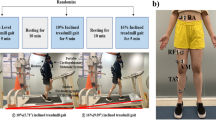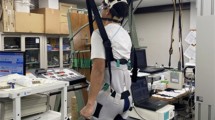Abstract
Purpose
Exercise intensity during walking can be increased by attaching an external load or accelerating the walking speed. However, the combination of these effects on the human body remains unclear. To investigate the influence of different walking speeds and ankle weight loads on metabolic and neuromuscular responses and lower limb kinematics during walking.
Methods
Twelve healthy participants walked on a treadmill under eight conditions (speed: 4 and 7 km/h × ankle weight loads: 0, 2, 4, and 6 kg). We recorded \({\dot{\text{V}}\text{O}}_{2}\), heart rate (HR), lower limb neuromuscular activities, and kinematic data.
Results
The interaction effect of speed and ankle weight load on \({\dot{\text{V}}\text{O}}_{2}\) and HR was significant (p < 0.05). \({\dot{\text{V}}\text{O}}_{2}\) and HR were higher during walking at 7 than 4 km/h (p < 0.05). \({\dot{\text{V}}\text{O}}_{2}\) rapidly rose with an increase in ankle weight loading from 4 to 6 kg during walking at 7 km/h compared with that at 4 km/h (p < 0.05). Rectus femoris proximal activity with 6 kg ankle weight loading was higher than that under the no-loading condition during walking at 7 km/h (p < 0.05). During walking at 4 km/h, medial gastrocnemius muscle activity with 4- and 6 kg ankle weight loading was significantly higher than under the no-loading condition (p < 0.05). All targeted lower limb muscle activity and the maximum hip flexion angle were greater during walking at 7 than 4 km/h.
Conclusion
Our results suggest that the effect of ankle weight loading on metabolic and neuromuscular responses is potentiated by a faster walking speed.




Similar content being viewed by others
Availability of data and materials
Data are available from the authors upon reasonable request.
Abbreviations
- AW:
-
Ankle weight
- ANOVA:
-
Analysis of variance
- EMG:
-
Electromyography
- GM:
-
Gluteus maximus
- HR:
-
Hurt rate
- MET:
-
Metabolic equivalent
- MG:
-
Medial gastrocnemius
- RFp:
-
Rectus femoris proximal
- VL:
-
Vastus lateralis
- \({\dot{\text{V}}\text{O}}_{2}\) :
-
Oxygen uptake
References
WHO (2010) Global recommendations on physical activity for health. World Health Organization. https://apps.who.int/iris/handle/10665/44399. Accessed on 14 Jun 2023
Ralston HJ (1958) Energy-speed relation and optimal speed during level walking. Int Z Angew Physiol. 17(4): 277–283. https://doi.org/10.1007/BF00698754
Aoyagi Y, Shephard RJ (2010) Habitual physical activity and health in the elderly: the Nakanojo Study. Geriatr Gerontol Int 10:S236–S243. https://doi.org/10.1111/j.1447-0594.2010.00589.x
Hallal PC, Andersen LB, Bull FC et al (2012) Global physical activity levels: surveillance progress, pitfalls, and prospects. Lancet 380(9838):247–257. https://doi.org/10.1016/S0140-6736(12)60646-1
Ainsworth BE, Haskell WL, Whitt MC, et al (2000) Compendium of physical activities: an update of activity codes and MET intensities. Med Sci Sports Exerc 32(9 Suppl):S498-504. https://doi.org/10.1097/00005768-200009001-00009
Browning RC, Modica JR, Kram R et al (2007) The effects of adding mass to the legs on the energetics and biomechanics of walking. Med Sci Sports Exerc 39(3):515–525. https://doi.org/10.1249/mss.0b013e31802b3562
Griffin TM, Roberts TJ, Kram R (2003) Metabolic cost of generating muscular force in human walking: insights from load-carrying and speed experiments. J Appl Physiol 95(1):172–183. https://doi.org/10.1152/japplphysiol.00944.2002
Ludlow LW, Weyand PG (2017) Walking economy is predictably determined by speed, grade, and gravitational load. J Appl Physiol 123(5):1288–1302. https://doi.org/10.1152/japplphysiol.00504.2017
Ribeiro F, Oliveira N, Pires J, et al (2014) Treadmill walking with load carriage increases aortic pressure wave reflection. Rev Port Cardiol 33(7–8):425–430. https://doi.org/10.1016/j.repc.2013.11.012
Soule RG, Goldman RF (1969) Energy cost of loads carried on the head, hands, or feet. J Appl Physiol 27(5):687–690. https://doi.org/10.1152/jappl.1969.27.5.687
Schertzer E, Riemer R (2014) Metabolic rate of carrying added mass: a function of walking speed, carried mass and mass location. Appl Ergon 45(6):1422–1432. https://doi.org/10.1016/j.apergo.2014.04.009
Royer TD, Martin PE (2005) Manipulations of leg mass and moment of inertia: effects on energy cost of walking. Med Sci Sports Exerc 37(4):649–656. https://doi.org/10.1249/01.mss.0000159007.56083.96
Washabaugh EP, Augenstein TE, Krishnan C (2020) Functional resistance training during walking: mode of application differentially affects gait biomechanics and muscle activation patterns. Gait Posture 75:129–136. https://doi.org/10.1016/j.gaitpost.2019.10.024
Fukuchi CA, Fukuchi RK, Duarte M (2019) Effects of walking speed on gait biomechanics in healthy participants: a systematic review and meta-analysis. Syst Rev 8(1):153. https://doi.org/10.1186/s13643-019-1063-z
Watanabe K (2020) Effect of seat tube angle and crank arm length on metabolic and neuromuscular responses and lower extremity joint kinematics during pedaling with a relatively lower seat height. Eur J Appl Physiol 120(3):697–706. https://doi.org/10.1007/s00421-020-04309-5
Watanabe K, Kouzaki M, Moritani T (2014) Regional neuromuscular regulation within human rectus femoris muscle during gait. J Biomech 47(14):3502–3508. https://doi.org/10.1016/j.jbiomech.2014.09.001
Watanabe K, Vieira TM, Gallina A, Kouzaki M, Moritani T (2021) Novel insights into bi-articular muscle actions gained from high-density EMG. Exerc Sport Sci Rev 49(3):179–187. https://doi.org/10.1249/JES.0000000000000254
Gottschall JS, Kram R (2005) Energy cost and muscular activity required for leg swing during walking. J Appl Physiol 99(1):23–30. https://doi.org/10.1152/japplphysiol.01190.2004
Ivanenko YP, Poppele RE, Lacquaniti F (2004) Five basic muscle activation patterns account for muscle activity during human locomotion. J Physiol 556(Pt 1):267–282. https://doi.org/10.1113/jphysiol.2003.057174
O'Brien MW, Kivell MJ, Wojcik WR, et al (2018) Step rate thresholds associated with moderate and vigorous physical activity in adults. Int J Environ Res Public Health 15(11):2454. https://doi.org/10.3390/ijerph15112454
Sugiyama K, Kawamura M, Tomita H, et al (2013) Oxygen uptake, heart rate, perceived exertion, and integrated electromyogram of the lower and upper extremities during level and Nordic walking on a treadmill. J Physiol Anthropol 32(1):2. https://doi.org/10.1186/1880-6805-32-2
Fan Y, Li Z, Han S, et al (2016) The influence of gait speed on the stability of walking among the elderly. Gait Posture 47:31–36. https://doi.org/10.1016/j.gaitpost.2016.02.018
Author information
Authors and Affiliations
Contributions
SK: conceptualization, methodology, formal analysis, investigation, data curation, writing—original draft preparation, visualization. HA: conceptualization, writing—review and editing, supervision, funding acquisition. KW: conceptualization, methodology, writing—review and editing, project administration, funding acquisition.
Corresponding author
Ethics declarations
Conflict of interest
The authors declare that they have no conflict of interest. This work was supported by AMED (Japan Agency for Medical Research and Development) [Grant number JP19le0110012]. The funding source had no involvement in study design, collection, analysis and interpretation of data, in writing the manuscript, or in the decision to submit for publication.
Ethical approval
The study was approved by the Research Ethics Committee of Chukyo University (No. 2019-002) and conducted in accordance with the Declaration of Helsinki.
Informed consent
All participants provided written informed consent.
Additional information
Publisher's Note
Springer Nature remains neutral with regard to jurisdictional claims in published maps and institutional affiliations.
Rights and permissions
Springer Nature or its licensor (e.g. a society or other partner) holds exclusive rights to this article under a publishing agreement with the author(s) or other rightsholder(s); author self-archiving of the accepted manuscript version of this article is solely governed by the terms of such publishing agreement and applicable law.
About this article
Cite this article
Kunugi, S., Akatsu, H. & Watanabe, K. Effect of ankle weight loading and walking speed on metabolic and neuromuscular responses and lower limb kinematics during treadmill walking. Sport Sci Health 20, 157–164 (2024). https://doi.org/10.1007/s11332-023-01084-6
Received:
Accepted:
Published:
Issue Date:
DOI: https://doi.org/10.1007/s11332-023-01084-6




